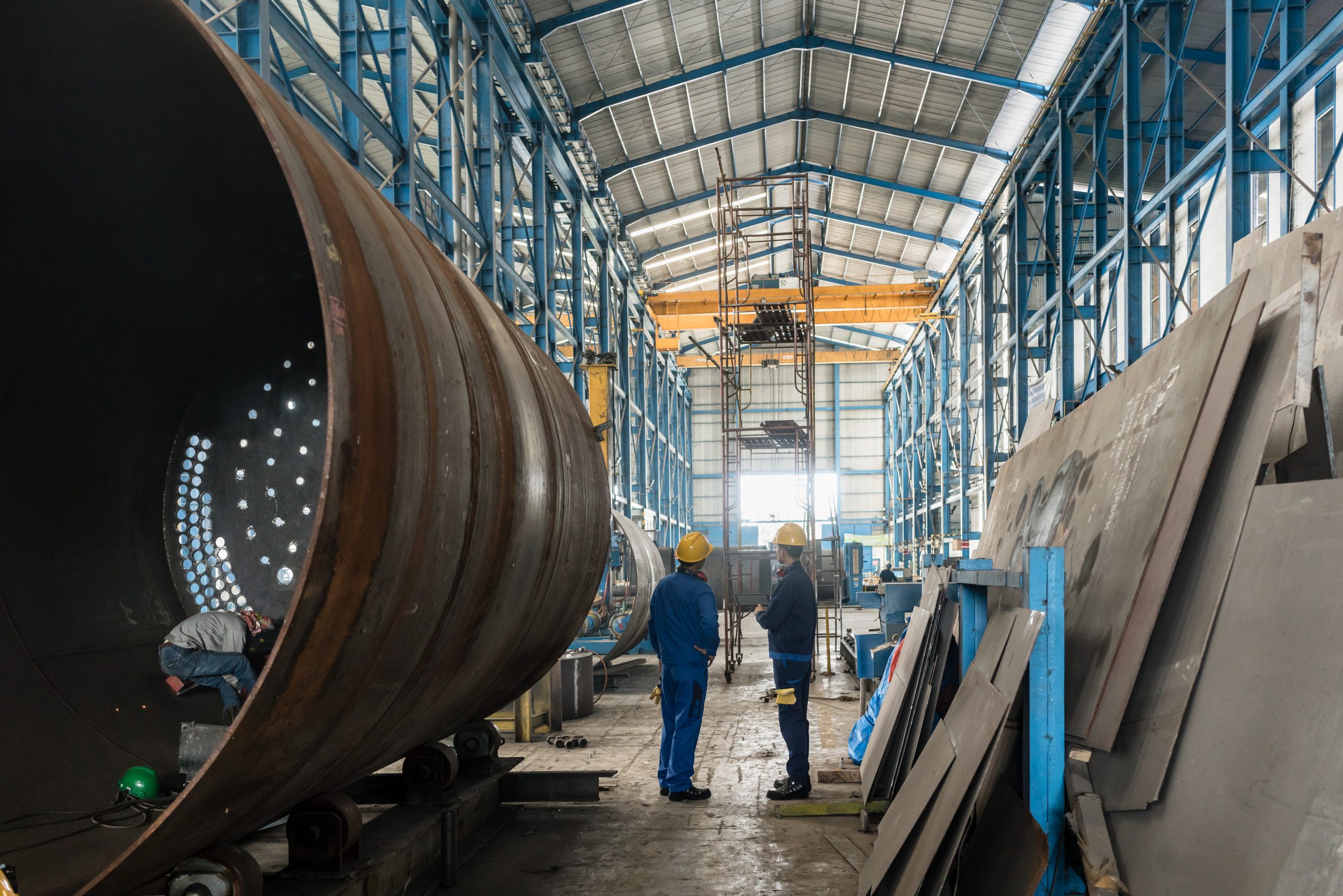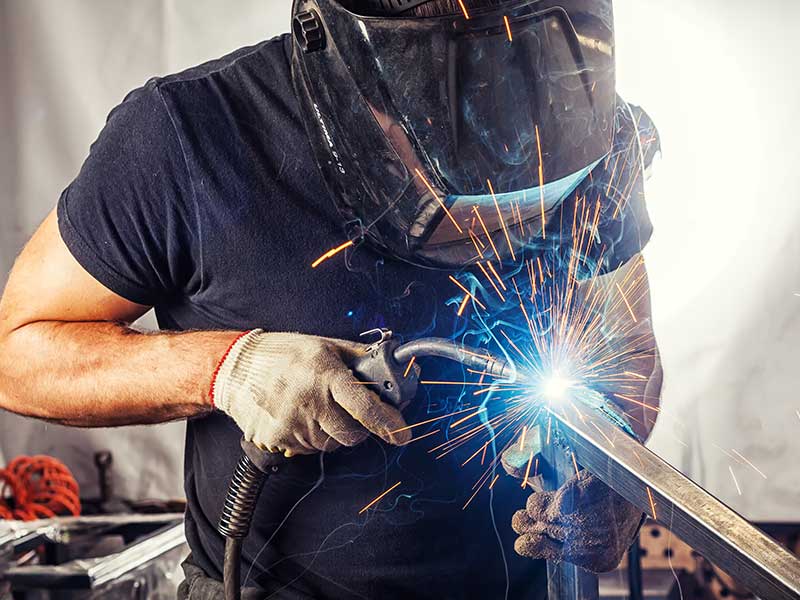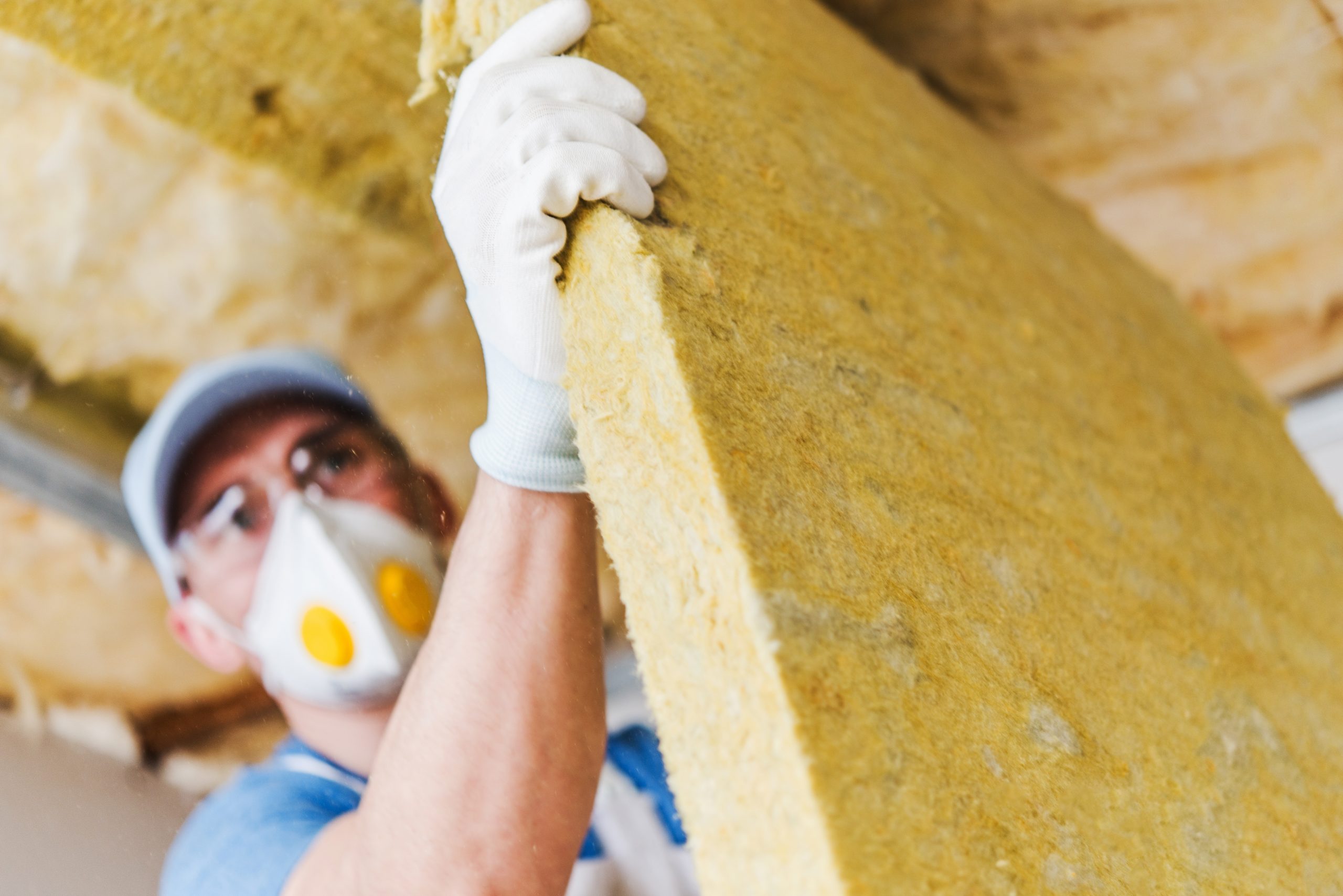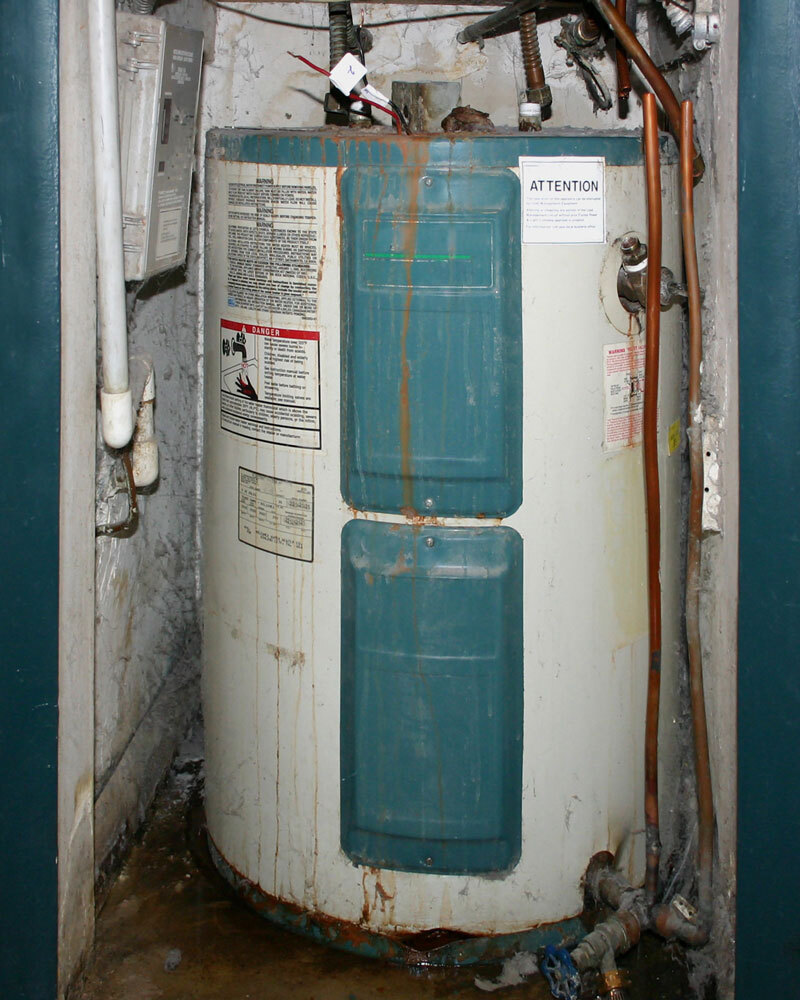Jobs & Mesothelioma Risk
Mesothelioma affects workers from all walks. It mainly affects blue-collar workers—active and retired. But it also affects white-collar workers.
They are at risk of developing mesothelioma if they have been exposed to asbestos. Asbestos exposure can happen at different times and places in a person’s life. But for people who work in certain trades or fields, the possibility of asbestos exposure is more likely than it is in other lines of work.
Click the icon of your choice below to read about the ways people in that occupation could have been exposed to asbestos and unknowingly opened themselves to mesothelioma.
Construction Workers & Asbestos Exposure
Fifty years ago, it was common to be exposed to asbestos at construction sites. Some of the projects built back then remain standing, which means renovators and others working on those structures today can still encounter asbestos.
Learn more.
Factory Workers & Asbestos Exposure
Factories contained asbestos in large quantities. Asbestos was contained in the materials from which the factory was built and operated. And it was contained in the factory’s product output.
Learn more.
Automotive Mechanics & Asbestos Exposure
Cars and trucks once contained lots of asbestos. Mechanics who worked on brakes, wheels, engines, transmissions, and electrical systems routinely encountered the carcinogenic mineral.
Learn more.
Ironworkers & Asbestos Exposure
The job of an ironworker involves being in proximity to asbestos-containing materials. These chiefly include insulated steel girders and beams using in building many types of residential, commercial, and industrial structures.
Learn more.
Electricians & Asbestos Exposure
Circuit breakers, blowout cages, and wires were in times past treated with asbestos to keep them cool and fireproofed as electric current flowed. Electricians routinely worked with these products.
Learn more.
Plumbers & Asbestos Exposure
Asbestos was used in pipes, gaskets, sealants, caulk, grout, and water heaters because of its excellent insulating properties. This put plumbers at risk of developing mesothelioma, asbestosis, and other asbestos-related diseases.
Learn more.
Painters & Asbestos Exposure
The oil-based paints used by painters in much of the 20th Century contained asbestos. The toxic mineral was added as an inexpensive thickener. It also was added to help paint lay down smoother, dry faster, and last longer.
Learn more.
Bricklayers & Asbestos Exposure
Whether used to build a foundation, a wall, a chimney, or anything else, they and the mortar to hold them together probably contained asbestos if manufactured from about 1930 until possibly as recently as 1990.
Learn more.
Welders & Asbestos Exposure
Asbestos once went into the making of welding rods, personal protection equipment, and more. Welders used these items in their daily work. Consequently, they risked inhaling or swallowing asbestos released into the air.
Learn more.
Machinists & Asbestos Exposure
Machinists faced asbestos exposure risk from the equipment they operated and the materials they handled. These exposures could lead to mesothelioma, asbestosis, or other asbestos-related problems.
Learn more.
Insulation Installers & Asbestos Exposure
Installers of insulation in the form of sprays, fills, jackets, batts, or wraparounds ran the risk of breathing in or swallowing asbestos fibers. Doing so could set the stage for serious medical conditions decades later.
Learn more.
Steamfitters & Asbestos Exposure
Many of the parts and materials used by steamfitters once routinely contained asbestos. The mesothelioma-triggering mineral was found in boilers, gaskets, steam pipes, and insulation.
Learn more.
One Asbestos Product,
Many Occupations Exposed To It
As a product containing asbestos is made, distributed, sold, installed, and maintained, it passes through a chain of hands representing numerous occupations.
Take, for example, a household water heater. Let’s say it was produced around the time the United States began landing astronauts on the moon.
Inside a water heater from that era would be—among other things—insulation. The purpose of that insulation was to prevent conduction of boiling hot temperatures from the internal water tank to the exterior metal shell, which is supposed to be relatively cool to the touch.
At the time of the moon landings, the insulating material used to prevent that sort of heat transfer was asbestos. Asbestos was used because it was abundant and cheap and because it was exceptionally good at blocking high heat.
These are some of the people who likely would have been exposed to that one water heater on its journey as an asbestos product…
Miners
They dug it up. When they did, massive amounts of tiny asbestos particles were released into the air. Winds could have carried those particles from the mine to the mining company’s offices and possibly into the nearby homes of the miners.
Materials Handlers
They received the asbestos ore and moved it around the processing plant as needed so it could be packaged for sale and distribution to fabricators that would further refine the asbestos into semi-finished or finished goods.
Truck Drivers
If asbestos arriving by train needed to go somewhere that a rail spur-line didn’t, it was transported aboard 18-wheelers, panel vans, and everything in between. The people in the cab of those vehicles and those who unloaded the dangerous cargo were likely exposed along the route or at the destination.
Warehouse Staff
At the water-heater insulation fabrication shop, the finished product was added to inventory. Shelf stockers and pickers were continuously jostling the product—and in so doing they would have caused asbestos fibers to break loose and find their way into the warehouse air.
Millwrights
They made sure the equipment at the processing plant and at the fabrication shops were in proper working order. That meant up-close inspections and hands-on repairs of conveyor belts and other systems likely coated with a light-to-heavy volume of asbestos.
Warehouse Staff
At the water-heater insulation fabrication shop, the finished product was added to inventory. Shelf stockers and pickers were continuously jostling the product—and in so doing they would have caused asbestos fibers to break loose and find their way into the warehouse air.
Plumbers
They might have purchased the water heater on behalf of a customer. Or they might have been asked to install one purchased by the customer direct from the retail store or other source. In either case, the water heater would have gone through plenty of handling during delivery and installation. That handling likely would have caused some asbestos to break free and go airborne. Even more asbestos would have been unloosed if an old water heater had to be removed and hauled away before the new one could be installed.
Assemblers
The asbestos-laced insulation materials the water-heater manufacturer acquired from the fabricator were then installed by semi-skilled laborers working on the assembly line. Their work was checked by supervisors and quality-control people. Other personnel boxed the completed water heaters, placed them in the warehouse, and eventually loaded them onto trailers or railroad boxcars for distribution. Everyone involved in these manufacturing steps likely was exposed to asbestos—some more so than others depending on the nature of the job and the conditions of the environment in which they worked.
Retailers
At the hardware store where the water heater was offered to the public, clerks assigned to the plumbing department daily worked near these asbestos-containing products. Each time a water heater was moved on and off the showroom floor, some of the asbestos within may have been disturbed, causing toxic fibers to begin floating in the store’s air.
Salespeople
They took samples of the insulation material to the offices of prospective and existing customers—the makers of water heaters and replacement systems. In addition to exposing themselves to asbestos, the salespeople also possibly would have exposed those with whom they met and presented samples.
Mesothelioma & White-collar Workers
Non-industrial occupations susceptible to mesothelioma, asbestosis, and other diseases related to asbestos exposure include those of business administration, education, healthcare, and personal services.
The primary reason these white-collar occupations are subject to mesothelioma risk is that they sometimes are conducted in older buildings (those erected prior to the 1970s when restrictions on asbestos in construction materials such as paint, pipes, wallboard, tiling, and insulation began).
The problem for secretaries, managers, executives, teachers, doctors, nurses, medical technicians, dentists, hair stylists, and others who did or still do work inside buildings 50 or more years old is that asbestos-containing construction materials deteriorate and lose their integrity as they age Loss of integrety means the asbestos can break free of the product and find its way into the indoor air where everyone in proximity might inhale or swallow some of the floating particles.
Asbestos also is released into an old building’s air if renovations are performed. For example, say there is an aged schoolhouse and one of its windows is broken. The pane—which has not been replaced since the school was built—is removed by first scraping away some of the putty that secured it to the frame. Prior to the 1970s, putty often contained asbestos. Scraping this putty allows asbestos particles to separate from it and become airborne. The teacher in this classroom is then at risk—unless the putty was removed using approved asbestos-mitigation procedures.
Sometimes white-collar people are exposed to asbestos from older equipment. Handheld blow dryers used by hair stylists as late as the 1990s contained asbestos. And oral-cavity molds that employed asbestos were once in common use among dentists.
All in all, during this one product’s journey along the chain of commerce, people performing jobs in a dozen different fields were exposed to asbestos. To this list could also be added occupations not directly involved in handling the water heater or the toxic material inside it. Those occupations might have included production-area floor sweepers, warehouse guards, and building inspectors.
Compensation is Available to People Who Develop Mesothelioma After Exposure to Asbestos
The companies that sourced, manufactured, distributed, or sold asbestos products can be made to pay for the costs of treating mesothelioma. As well, they can be made to pay for lost wages, pain-and-suffering, and other damages resulting from asbestos-caused mesothelioma. The same is true for asbestosis.
Learn more about available compensation by talking to an extensively experienced mesothelioma lawyer with a history of successful mesothelioma verdicts and settlements. Get a free case review.
Start by clicking here.
Get a FREE case review.
How much compensation can be obtained from these options depends in large part on the knowledge, skill, and experience of the attorney representing the patient. Go here to talk to an asbestos lung cancer-focused lawyer.

About the author…
Sara M. Salger received her undergraduate degree from Southern Illinois University Edwardsville, graduating cum laude, and Saint Louis University School of Law for her J.D. where she received an International Law Certificate and litigation focus.












